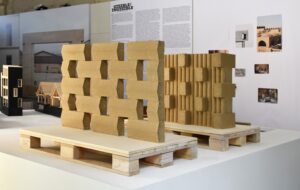|
|
||
|
In the summer of 1972, MoMA in New York held an unexpected blockbuster of an exhibition curated by the young Emilio Ambasz called Italy: The New Domestic Landscape. Its success lay in its strategy of mixing media, architecture and design to communicate and propose new ideas to the public about architecture and the environment. Until this point, Italian design had only been considered in terms of industrial production, particularly in the context of its miraculous post-war boom. Besides the “pro-design”, or the objects of industrial design by figures such as Ettore Sottsass Jr and Joe Colombo, the MoMA exhibition hosted radical “counter-design” proposals that used design as a tool of social critique. Italy: The New Domestic Landscape occurs exactly halfway through the time period described in Catharine Rossi and Alex Coles’ anthology and can be considered its climax, from which the “radical architecture” movement emerged and Italian postmodern design was ultimately born. The interviews, essays and reminiscences contained in the book describe a moment in time when one generation was giving way to its successor. The beginnings of this struggle lay in the 1963 occupations of architecture schools in Milan, Turin and Rome: students were protesting against the antiquated curriculum. Everything kicked off across Europe in 1968 and the Milan Triennale and Venice Biennale of this year were both occupied. These hallowed institutions were irreversibly changed as a result. This fracas is outlined in Paola Nicolin’s T68/B68 chapter and, as Antonio Negri describes in the interview at the end of the book, Italy’s protests lasted a full ten years. This decade of instability essentially defined the revolutionary mission of the avant-garde during the period. Interestingly, however, Negri insists that art and design’s contribution remained secondary to the real business of class politics.
credit Gruppo 9999, collage for the S-Space Mondial Festival, coorganized with Superstudio, Florence, 1971. Courtesy of Carlo Caldini. (c) Gruppo 9999. Utopia and/or revolution is a theme that underpins the contributions to the book and, although it doesn’t explicitly appear here, was the title of a symposium and exhibition organised by Turin’s faculty of architecture in 1969. A who’s who of avant-garde groups from around Europe gathered to discuss the increasing commodification of culture and whether utopia and/or revolution were still relevant or possible. Several of the groups described in the book had given up on the idea of utopia and were striving to redefine it through a revolution in art, design and architecture. The most enduring images of this dissatisfaction are arguably derived from Archizoom’s No-Stop City and Superstudio’s Continuous Monument. Utopian thinking taken to its absurdly logical conclusions, these deliberately unbuildable projects criticised the modernist project and its relationship to consumerism as it was then evolving. Other strategies in the socio-political critique of architecture, such as anti-design and the dematerialisation of architecture, are explored in Rossi’s essay, through the little-known Cavart group, and Alison J. Clarke’s vignette on Ettore Sottsass. Whether through truculence or simple lack of opportunity, there is a clear rejection of atavism and the values of the older generation, and a desire to return to basics in order to reassess the authoritarian figures of designers and design in society. And we are constantly reminded of the role of magazines, especially Domus and Casabella, in the production and promotion of the radical architecture movement and groups. All this, and more, is covered in this quaffable first volume of the new series EP (Extended Play). It’s more an introductory text than deep analysis, but as there is surprisingly little published in English on this period of Italian architectural history, it hits a sweet spot. Of course, it shouldn’t preclude an LP or even a double album on these under-explored and fascinatingly complex movements and events that are just appearing over the horizon of historical respectability. EP/Vol 1: The Italian Avant-Garde 1968-76, edited by Catherine Rossi and Alex Coles, Sternberg Press, €22. |
Image Paolo Lomazzi, Jonathan De Pas, Carla Scolari, and Donato D’Urbino, Blow armchair, 1967. Zanotta, PVC. Photo by Zanotta Spa – Italy
Words Steve Parnell |
|
|
||


















